Back when the world was evolving from the crude age, the Industrial Revolution had set in. There existed great minds who were behind designs in the 1800s.
They have tried improving the earth to create a secure future, even in their unconscious minds.
For everyone who contributed an idea to change their surroundings, little did they know they were doing the world great favors today.
Through these innovations, they have created pathways for more solutions in this century. The pleasure is all mine as I take you through some of these powerful innovations.
- Here's a List of 30 Inventions between 1800 and 1899
- 1. Invention: Battery
- 2. Invention: Stethoscope
- 3. Invention: Matches
- 4. Invention: Microphone
- 5. Invention: Typewriter
- 6. Invention: Sewing Machine
- 7. Invention: Mechanical Reaper
- 8. Invention: Corn Planter
- 9. Invention: Dishwasher
- 10. Invention: Bicycle
- 11. Invention: Mechanical Calculator
- 12. Invention: Telegraph
- 13. Invention: Postage Stamp
- 14. Invention: Gyroscope
- 15. Invention: Airship
- 16. Invention: Glider
- 17. Invention: Vacuum flask
- 18. Invention: Gramophone
- 19. Invention: Traffic Light
- 20. Invention: Telephone
- 21. Invention: Carpet Washer
- 22. Invention: Motorcycle
- 23. Invention: Escalator
- 24. Invention: Roller Coaster
- 25. Invention: Diesel Engine
- 26. Invention: Automobile
- 27. Invention: Barbed Wire
- 28. Invention: Stapler
- 29. Invention: Portland Cement
- 30. Invention: Tin Can
- Most Recognized Inventors between 1800-1899
- Conclusion
Here’s a List of 30 Inventions between 1800 and 1899
1. Invention: Battery
Date of Invention: 1800
Invented by: Alessandro Volta

Volta’s electric battery. Source: GuidoB/wikimwdia commons
A battery is a chemical reactor that stores energy, which can be used in electrifying.
As a chemical reactor, the primary function of a battery is the production of electrons mobilized to go through or power an external device.
Nowadays, batteries are needed everywhere and have been a better invention for the present world.
The known inventor of the battery is Alessandro Volta.
He was born in Como, Italy, in the year 1745. Born into a wealthy home, he grew up to become a trained physicist and chemist.
His batteries were made with Copper and Zinc discs and were parted by clothing soaked in saltwater.
Electricity was conducted into the wires connected to both discs, through a stable current. He was the first scientist to patent the battery.
Through his invention, he became the pioneer of power generation and proved that electricity could be generated through a chemical medium.
Other designs followed after the battery, but he is mostly recognized for inventing the battery.
2. Invention: Stethoscope
Date of Invention: 1816
Inventor: Rene Laennec
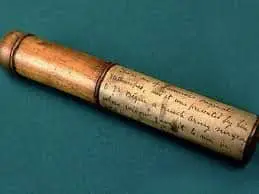
Stethoscope. Source: Pinterest
When medical practitioners needed to check the heartbeat of patients, they were only limited to placing their ears carefully on a patient’s heart.
There was no means of auscultation, and the old medium always does not yield the desired results.
In 1816, a man named Rene Laennec thought of how to listen carefully to the sounds in the chest.
He couldn’t use the usual method to examine his fat patient.
He started by rolling a sheet of paper into a tube shape, placing each end on the patient’s heart and ear.
The sheet of paper was later replaced with a hollow tube made from wood over the years. The wooden tube was changed, and improvements were made to this invention.
Rene named his device the Stethoscope.
Today, a stethoscope has become a very vital piece for doctors. Modern Day stethoscopes can amplify the sounds in the chest.
3. Invention: Matches
Date of Invention: 1826
Inventor: John Walker

Matches. Source: jef-infojef/Wikimedia Commons
Before this invention, lighting the fire was almost an unknown thing to everyone.
Fire has been in existence for thousands of years, but no one knew how to create or start one ideally.
The first idea of lighting a fire was brought about by a British Pharmacist, John Walker, in 1826.
This invention came by accident when Walker had to scrape off the coated gob while mixing chemicals with his mixing stick.
The mixing stick struck against the hearth in his house and boom; he cracked it.
Walker sold his first set of matches in 1827, packed in a box, and came with a sandpaper piece.
Every other development came under this idea.
4. Invention: Microphone
Date of Invention: 1827
Inventor: Charles Wheatstone

Microphone. Source: Fiddlersgreen
Charles Wheatstone is formally known as a physicist and the father of many devices. He hailed from Gloucester, England, and was born on 6th February 1802.
Later after he invented the microphone, he became a professor of philosophy in 1834.
His invention was based on how to transmit sound waves through mediums from one place to another, regardless of the distance.
His curiosity to come up with something to convey sound led to the microphone being invented.
A microphone can propagate weak sound waves to become audible.
Wheatstone is a household name in the field of physics. He would later contribute to many inventions.
5. Invention: Typewriter
Date of Invention: 1829
Inventor: W. A Burt
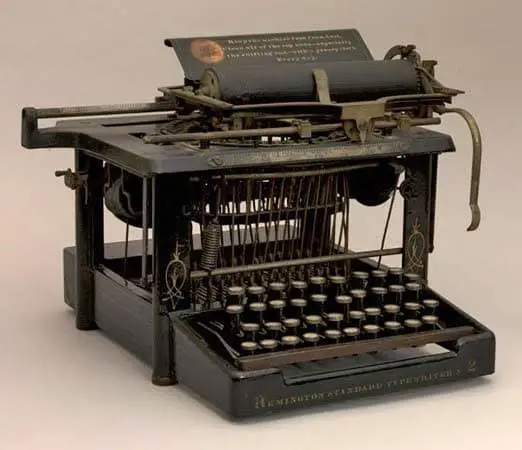
Typewriter. Source: Britannica
The first generation of the typewriter was invented in 1829; at that time, there were no other means by which people could write letters, or document anything other than writing.
A typewriter is a manual machine with keyboards, used for typing out data.
An American inventor named William Burt was the first to patent the typewriter. From the start of the 1850s, the typewriter became very useful in offices and media houses.
It would later be improved by contributions like Samuel Soule, Carlos Glidden, and Christopher Sholes.
They were the principal contributors to the booming success of the invention, after developing varieties of typewriter.
6. Invention: Sewing Machine
Date of Invention: 1830
Inventor: Barthelemy Thimonnier
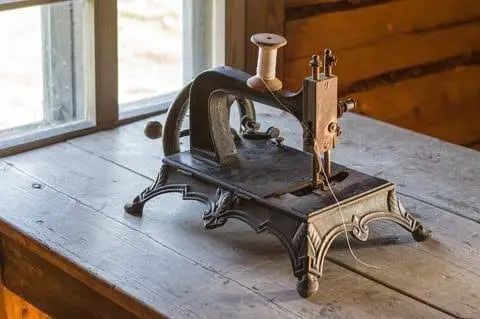
Sewing machine. Source: ABC
The period of revolution was still on in France, in the year 1830. In a city located in the south of Paris lived a tailor.
He was popularly known as Bart. He developed the first mechanical tool known as the sewing machine.
The machine at the time was a hooked tambour needle operated in a chain stitch form.
It was later rejected, and Bart’s workshop was destroyed after he began executing large contracts for the military.
Usually, local tailors at that time made money from stitching with bare hands; the only crude means they had to settle for.
The fear of losing their jobs to the mechanical machine made them hate Bart’s invention. This was the first type of sewing machine ever designed.
The further upgrade was also recognized after Bart’s sewing machine.
7. Invention: Mechanical Reaper
Date of Invention: 1831
Inventor: Cyrus McCormick
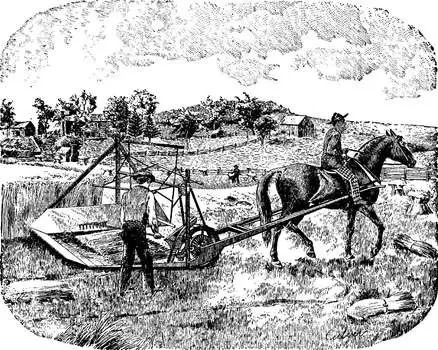
Mechanical reaper. Source: Britannica
Before the 18th century began, farming was a bit tedious because everyone had to work with their hands.
With crude handmade hoes, the farming process was always long and required energy until the industrial revolution came to man’s rescue.
Born on a remote farm in Virginia, USA, in 1809, Cyrus McCormick grew up on the farm with his parents.
Harvesting crops took a lot of time, and a change was needed.
He took over his father’s project decades after he tried inventing the mechanical machine to replace sickles.
In 1831 Cyrus successfully built a reaper that was efficient to replace hundreds of labor.
8. Invention: Corn Planter
Date of Invention: 1834
Inventor: Henry Blair
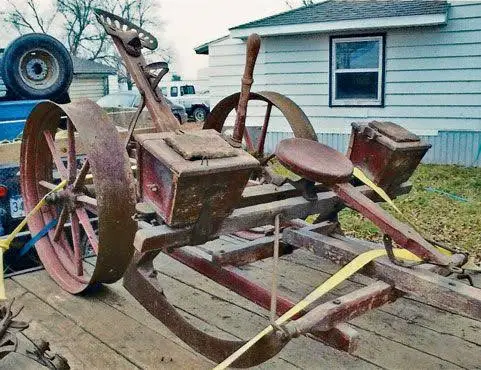
Corn reaper. Source: Pinterest
Henry Blair was the known inventor of the corn reaper, the mechanical machine that hastened the planting of maize.
Born in 1807, he grew up in Maryland as the dorm of a farmer. He is the second African American to patent an invention and is being referred to as a free man.
The popularity came in1834 when the corn planter he invented saved time and energy of planting for a long time.
The corn planter helped control weeds as well. Henry had to declare himself a free man before he could patent the corn planter.
9. Invention: Dishwasher
Date of Invention: 1886
Inventor: Josephine Cochran

Dishwasher. Source: Wikipedia
This invention was birthed from a personal interest, and it was sold throughout the world after drawing much attention.
The patent inventor, Josephine Cochran, was born into a skillful and wealthy home. She was 47 when she thought of creating a solution for her cracked dishes.
She and her husband were known for entertaining visitors most time; she needed a solution to her plates, always breaking and getting cracked.
Her friend aided her in developing a machine to wash dirty dishes instead of paying her staff and still losing plates.
The first set of dishwashers produced by Cochran was named after her.
It later gained fame through the help of her businessman husband.
10. Invention: Bicycle
Date of Invention: 1839
Inventor: Kirkpatrick Macmillan

Bicycle. Source: Graces Guide
Before the introduction of wheel machines, there were no mechanical means of moving around or traveling.
Kirkpatrick Macmillan completed the invention of the first pedal bicycle. The idea behind his design was a hobbyhorse he admired.
He was brought up in Dumfriesshire, Scotland, and served as a blacksmith apprentice under his father. He acquired a few skills that allowed him to build a stable bicycle.
After successfully riding through 14 miles in one hour, he wasn’t ready to patent the first pedal bicycle for business purposes.
Other pedal bicycles made after this first design helped unleashed the potential of the bike as a means of transport.
11. Invention: Mechanical Calculator
Date of Invention: 1932
Inventor: Charles Babbage
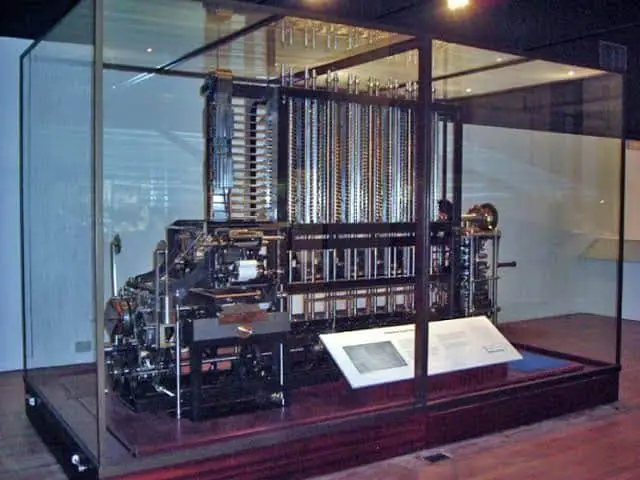
Mechanical calculator. Source: Interesting engineering
The history of calculators can be traced way back to 1822 when Babbage began with a small model of calculator.
His invention could sum up, differentiate or multiply numbers and could print mathematical tables. The machine was called a different machine at that time.
It took him three years to come up with a different machine.
After the different machine was built successfully, the British government approached him to help develop a similar machine.
This project took him several years, just like a usual engineering project.
The said project was halted when there was a shortage of funds. But then, a working portion was already made.
The complete project would later weigh about 13 metric tons. For this invention, Charles Babbage was often regarded as one of the fathers of computers.
12. Invention: Telegraph
Date of invention: 1834
Inventor: Samuel Morse
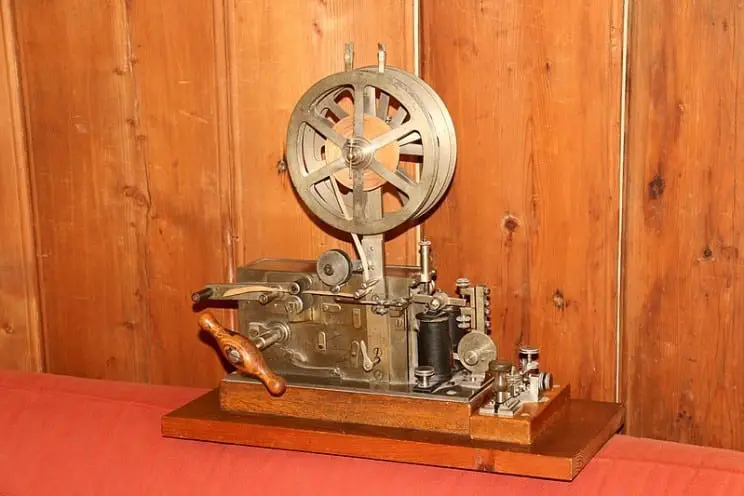
Telegraph. Source: Hp. Baumeler/Wikimedia Commons
The first telegraph was built by Samuel Morse, an invention that would later be worked on by other inventors.
Morse was born in 1791 and was 43 years when he created the first telegraph.
During the industrial revolution era, there was a need to access long-distance messages.
The telegraph was the first machine to transmit signals over to stations through a wired connection.
Morse is an American, and his first telegraph was sent from Washington D.C. to Maryland.
The telegraph had been accepted across Europe, in the year 1866, telegraph lines were laid across the Atlantic connecting Europe.
Recently, the availability of the internet, fax machine, and telephone have limited telegraph usage.
But it was the pioneer means of passing information, and it has paved the way for communication innovations.
13. Invention: Postage Stamp
Date of invention: 1837
Inventor: Rowland Hill
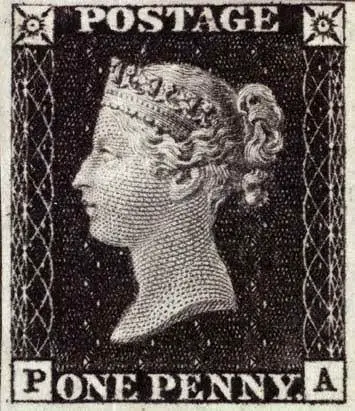
Postage stamp. Source: British Library
Born and brought up in England, Rowland Hill was working as a schoolmaster when he invented the postage stamps.
After a few years of authenticating his innovation, the world’s first stamp was issued in 1840 in England. Rowland was later knighted as a reward for his invention.
His first stamp rates were judged on weight instead of size. Before the postage stamp came into existence, older means were not trusted to get the job done.
He first described his postage stamp in his own words when summoned before the Commission for Post Office Enquiry.
14. Invention: Gyroscope
Date of invention: 1852
Inventor: Leon Foucault
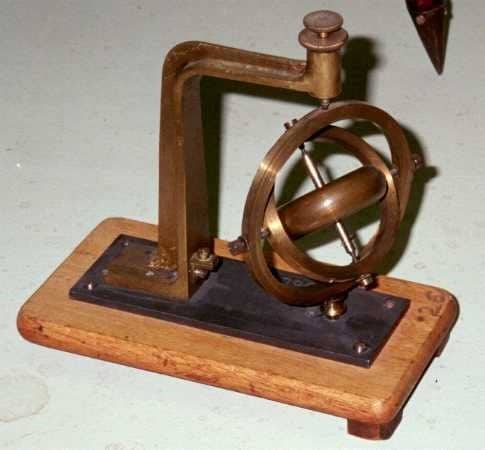
Gyroscope. Source: Kenyon College
Leon Foucault was a French Physicist born in 1819.
He was the first to patent the gyroscope, a design that could tell the plane of the earth’s rotation depending on its location’s latitude.
He was born in 1819, and in 1852, he invented the first known gyroscope.
It took him some time, but his approach was clear; he made a gyroscope out of a swinging rotating ball with a weighty rim.
The period of rotation was dependent on the latitude of the location. The technique behind the investigation was almost not easy to prove as frictional forces slowed down the spinning system.
This idea is common among kids with a toy gyroscope.
15. Invention: Airship
Date of Invention: 1852
Inventor: Henri Giffard
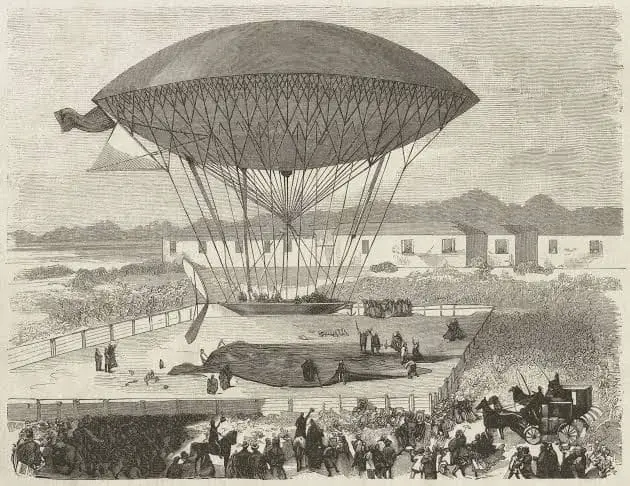
Airship. Source: ThoughtCo
Born in France on the 8th of February 1825, Giffard grew up to become an engineer and a father of a few innovations.
He made the first airship, after which other developments followed. A sufficient gas powered the airship with a propeller.
The size of this first airship consists of 125meter in length and 25 meters in diameter. The engine is a 3-horsepower steam type.
The steam engine was joined to the propeller and flew seventeen miles at 5 meters/hour.
Over the years, different designs and structures of airships started appearing.
Giffard owned this invention and became one useful surveillance craft for the military a few years later.
16. Invention: Glider
Date of Invention: 1854
Inventor: George Cayley
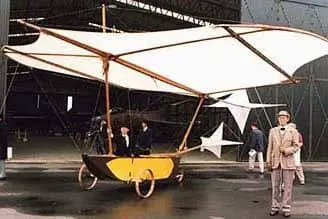
Glider. Source: fiddlersgreen
George Cayley was born and brought up in Yorkshire, England. He is the first known engineer and inventor to patent the glider.
His aeronautical engineering skills made things easier for him during that time.
His first glider was a webbed aircraft built like an image of a bird.
He saw the need to patent his invention after successfully flying the glider over a few miles with someone in the plane at the time of flight.
He died shortly after patenting the glider, and after then, various developers saw the need to improve the glider’s design.
Popular contributors after George made the first glider were Otto Lilienthal and the Wright brothers.
17. Invention: Vacuum flask
Date of Invention: 1892
Inventor: James Dewar
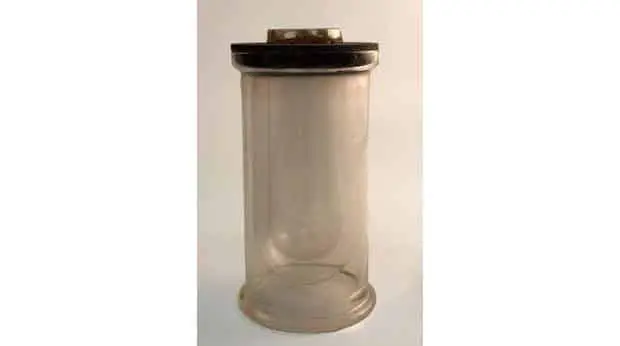
Vacuum flask. Source: BBC
Vacuum flasks were popular for preserving cold liquids. The inventor, James Dewar, specializes in cryogenics, the science of cold.
In recent times the vacuum flask has been a valuable part of almost everyone, helping us keep our liquids hot.
Dewar had to prevent cold liquids from evaporating; he tried various means using different materials. He ended up designing a vacuum made with a double-walled flask.
In between the wall of both glasses, there’s no room for air.
The vacuum ensured that the liquid stored inside the flask maintains its temperature due to the absence of air.
Other designs of the vacuum flasks had silver coatings on the vacuum walls to prevent the transmission of heat.
18. Invention: Gramophone
Date of Invention: 1887
Inventor: Emile Berliner
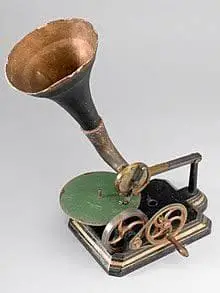
Gramophone. Source: Wikipedia
Emile Berliner wasn’t an American, as some people think. He moved from his country Germany to Washington D.C.
Long before the music started recording on a disc, there was no means of having a personal music player to play your best songs repeatedly.
Emile made a stop to recording on cylinders in 1887, the year he also patented it. He made songs on discs and complemented them with a gramophone for playing the disc.
A needle-like object attached to the arm of the gramophone transmitted the sounds and vibrations to the gramophone.
His gramophone gained more fame after he created a company and convinced artists to record with his systems.
19. Invention: Traffic Light
Date of Invention: 1868
Inventor: John Knight

Traffic lights. Source: Science ABC
It was a year to forget for Londoners as the number of injuries and death caused by accidents was more than 2000.
A railway worker, John Knight, proposed a signaling system on transport routes. His proposal was backed by his invention of the first traffic lights ever made.
The lights became a good bargain For Knight and the government. The traffic lights were first used at George and Bridge Streets.
The lights consist of red and green color types for stop and proceed respective signaling.
These lights didn’t last till 1870, but they were a stepping stone for the recently improved technology in modern-day transportation.
20. Invention: Telephone
Date of Invention: 1876
Inventor: Alexander Graham Bell

Telephone. Source: IMGBIN
One of the most remarkable inventions that changed the world and aided smooth communication between people.
Graham Bell was born in Scotland but became an American later in his life. He is the first scientist to receive a patent for inventing the telephone.
Despite his countless inventions, Bell loved to be regarded as a teacher of the deaf. He was born in 1847 to a teacher and an impaired organist mother.
Growing up, he didn’t see himself as a bright student but had a talent for solving problems.
He once made a husk remover for his friend’s dad, who works on a wheat farm.
21. Invention: Carpet Washer
Date of Invention: 1876
Inventor: Melville Bissell

Carpet washer. Source: Bissell
Melville was born in Michigan and was a trader at the time he invented the carpet washer. He owns a tableware shop with his wife, Anna.
Before the industrial revolution, floors were made of wooden material or cement, so it was easy to swap and clean with brooms.
When carpets and rugs started selling, and the carpet beating was such a hard task, there was a need to design a cleaner for them.
Melville’s shop was laid with carpet, and all the goods came in wooden boxes that have sawdust in them.
The sawdust would litter everywhere, and it became a thing of concern for Anna.
Melville made a carpet cleaner for her so that their business could run smoothly.
He made her an opened wooden box with wheels that are being pushed with the help of a long handle.
22. Invention: Motorcycle
Date of Invention: 1885
Inventor: Gottlieb Daimler
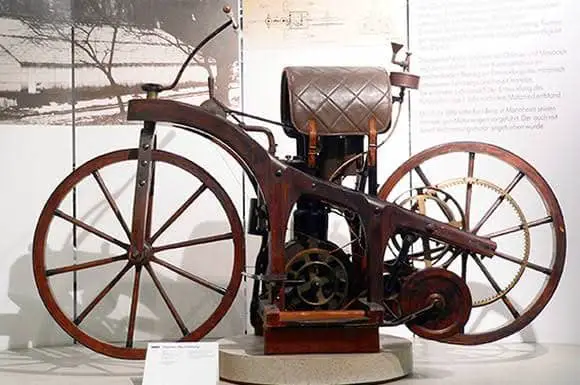
Motorcycle. Source: Wired
The development of the first combustion engine that ran on two wheels and two other supporting wheels was the work of German engineer Gottlieb.
He patented his invention of powering a wooden vehicle with the combustion engine on wheels in 1885.
The two added wheels for support made people condemn the motorcycle.
The combustion engine was a four-stroke gasoline type. Production of motorcycles followed shortly after the invention of the bicycle.
Gottlieb’s son was the first to ride the motorcycle for nearly 10km.
The support wheels on the first motorcycle would later be removed after recent improvements from other contributors.
23. Invention: Escalator
Date of Invention: 1892
Inventor: Jesse Reno
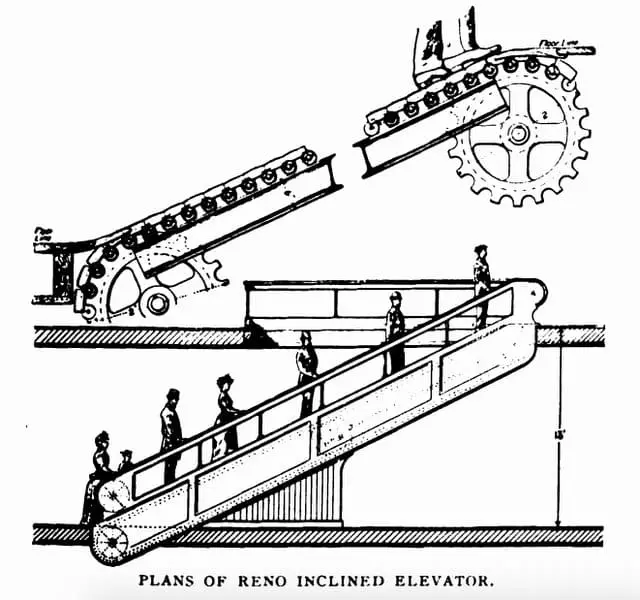
Escalator. Source: untappedcities.com
The history of escalators could be traced back to the amusement park, where it first started for amusement purposes.
A similar design that relates to Reno’s escalator was a machine designed in 2859. His escalator is a transport aid machine that works on a conveyor belt.
Its primary function is to move people from one height or distance to the other.
Jesse Reno received the due credit for inventing the machine like this in 1892, a time when the industrial revolution was shaping Europe and America.
It promoted urbanization and productivity as it is widely used today.
Reno’s novelty ride at Coney Island was created in 1895, designed from the original design.
24. Invention: Roller Coaster
Date of Invention: 1898
Inventor: Edwin Prescott
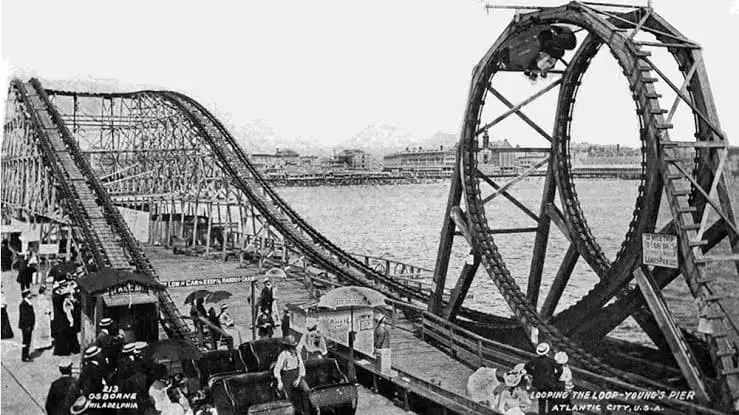
Roller coaster. Source: popsci
One of the major attractions in any amusement park to date is still the roller coaster. Some kids usually have the best time of their lives when they’re on a rollercoaster ride.
The history of this fun machine is a simple science of centrifugal force, coined by Edwin Prescott, a specialist in mechanics who hails from South Dakota.
It was first named the centrifugal railway when it was invented in 1898.
It was dependent on centrifugal force and a loop that only allows 4 to 5 riders every 5 minutes.
The improved machines followed suit after Edwin’s.
25. Invention: Diesel Engine
Date of Invention: 1893
Inventor: Rudolf Diesel
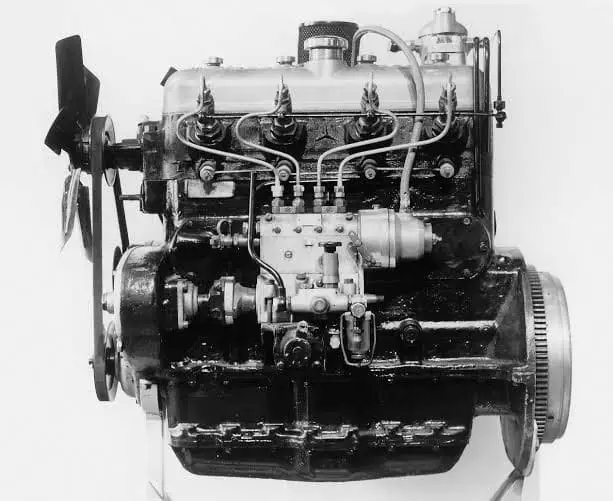
Diesel engine. Source: DieselNet
Having studied engineering at the Munich Polytechnic Institute, Rudolf Diesel was a talented German engineer who grew up in France.
His initial aim in inventing the diesel engine was to assist small business owners.
Today, diesel engines are preferred in some parts of the world by major automobile producers.
The majority of the trucks and heavy-duty vehicles park on diesel engines, even plants. It is widely accepted by industrialists nowadays.
Before inventing the diesel engine, he once worked as a thermodynamics engineer in France.
This invention took helped the 1st and second industrial revolution eras.
It cannot be erased from the history of innovations, save for Diesel’s death.
26. Invention: Automobile
Date of Invention: 1885
Inventor: Karl Benz
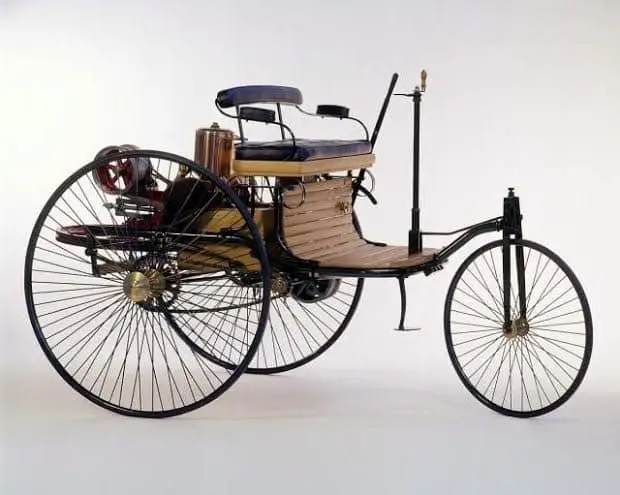
Automobile. Source: Pinterest
One of the world’s largest automobile brand to date started in Germany and are still relevant.
The history of vehicles or automobiles could be traced back to 1885 when Karl Benz took it upon himself to design a life-changing motor, powered by a combustion engine.
The patent for inventing the automobile was received in 1886.
He built all the parts of the automobile himself, including the spark plugs, carburetor, gear, clutch, ignition, and water radiator.
The first automobile to be produced by Karl Benz was a three-wheel vehicle called Motorwagen. The combustion engine depended on hydrocarbon to start.
He also built the first-ever known four-wheeled vehicle in 1891 and started his business, which he called Benz and Company.
He’s the first recognized, licensed driver in the world.
27. Invention: Barbed Wire
Date of Invention: 1868
Inventor: Michael Kelly

Barbed wire. Source: Wikipedia
Recent tales about how the barbed wire came into existence were traced to different inventors and contributors, but one known man was the brain behind this innovation.
Michael Kelly was granted a patent for the barbed wire invention in 1868. Nowadays, barbed wires are used for fencing houses more than farmlands.
Barbed wires were handy in the 1800s; they changed things in the west in its early days.
Wires were used for fencing farmlands when wooden fences were expensive to afford.
It was essential to fence one’s farmland back then; else, livestock will eat up the crops.
On the other hand, lumber was short in supply; deforestation would be in high demand if wooden fences continued.
Kelly turned things around with his invention.
The method of fencing was changed from wooden fences to wired fencing when barbed wire became common in the west.
28. Invention: Stapler
Date of Invention: 1841
Inventor: Samuel Slocum
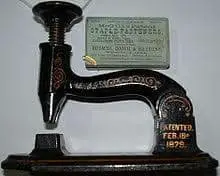
Stapler. Source: Wikipedia
Pins are not only used for pushing threads into clothes, when the first set of conventional pins was made in 1835, little did we know that everything came to fall in place for today’s purpose.
Slocum invented the pin-making machine; the pins came in solid heads and were used to tack a joint or make something firm.
His eagerness to get pins stocked with papers led to his staple invention.
The essence of making the stapler was to create a machine that forces pins into paper from a grooved plate.
The first stapler looks very different from what we know now. It was solely used for holding papers together when papers became everyone’s writing material.
29. Invention: Portland Cement
Date of Invention: 1824
Inventor: Joseph Aspdin
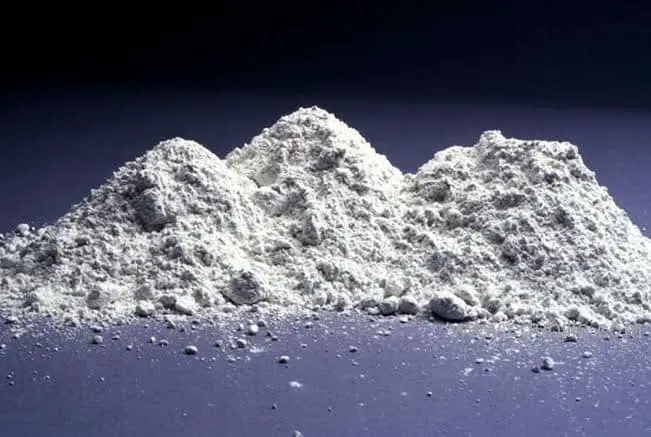
Portland cement. Source: Edubilla
Joseph Aspdin is an Englishman who grew up as a bricklayer to become a builder later in life. He is the first to patent a chemical process is known for making Portland cement. This is one of the inventions that shook the world; it came at the right time it was needed.
Portland cement is one essential substance needed for every construction.
The chemical process involved stirring clay and limestone together to almost 1,400 degrees centigrade.
It is later ground to powder and mixed with sand to make concrete, mix with sand and gravel.
The first major construction built with Portland cement is the Thames Tunnel, later it was used to build the London sewage system. After these, it was widely accepted.
30. Invention: Tin Can
Date of Invention: 1810
Inventor: Peter Durand

Tin can. Source: Interesting Enginnering
The tin can was first invented in 1810; it is surprising and unusual how well it has helped in food preservation and drink storage in modern days.
Little did Peter Durand know he was doing the world a great favor when he first invented the tin can.
The first company to produce tin cans in quantities came after it was first developed.
John Hall and Bryan Dorkin took credit for mass production of the tin can, but they weren’t adequate to go around.
Decades later, Henry Evans made a faster machine that could double the output.
Durand’s tin can was hard to open, except if you have a hammer to bust it open.
Subsequent production had to focus on thinner walls and a key can opener that can still be found in modern cans like that of sardines.
Most Recognized Inventors between 1800-1899
1. Gottlieb Daimler
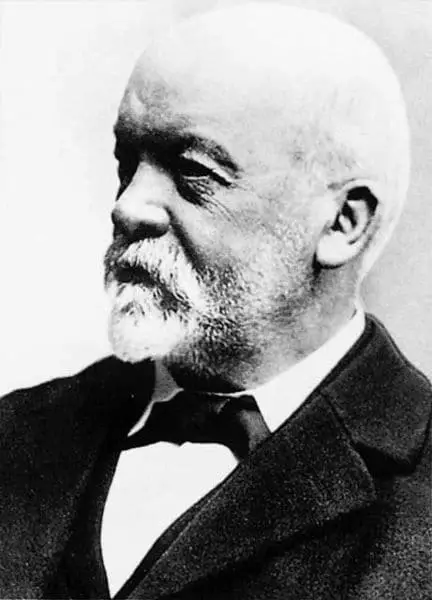
Daimler was born in Schorndirf, Germany, in 1834.
He grew up to become an engineer and inventor, although his father wanted him to be a municipal employee at that time.
He had so much passion for science and skills, that he worked as an apprentice under a gunsmith for four years.
He furthered his education at Stuttgart Polytechnic, where he gained the much-needed knowledge for inventing the first motorcycle with his internal combustion engine.
Before the period he invented the motorcycle, he once worked in a steam engine factory.
He is otherwise known as a designer and one of the pioneers of the internal combustion engine.
2. Emile Berliner
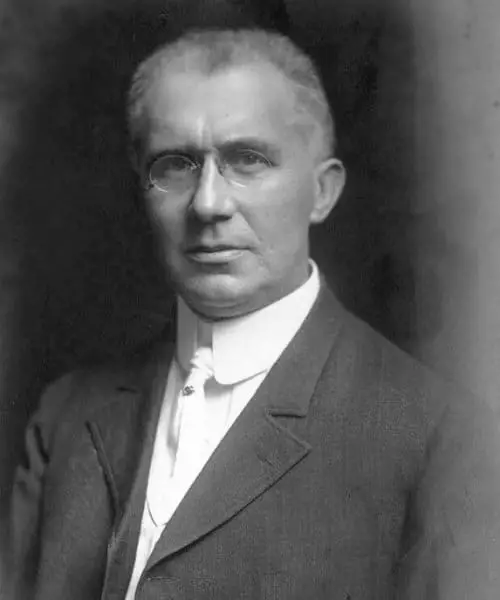
Berliner was born in Germany but grew up in Washington D.C. He is one out of 13 children of his parents.
He had all his primary schooling in his homeland and moved to Wolfenbuttel.
He worked a few years in Hanover for his large family before finally moving to the USA at age 19. He learned a few things about physics in New York.
He is popularly known for inventing the gramophone and flat disc phonograph records, but before that, he once made his version of Graham Bell’s telephone that had a better microphone, which he later sold.
He became a U.S. citizen in 1881 when he married his wife, Cora Adler.
His invention propagated the recording of songs on inexpensive discs.
3. Alessandro Volta
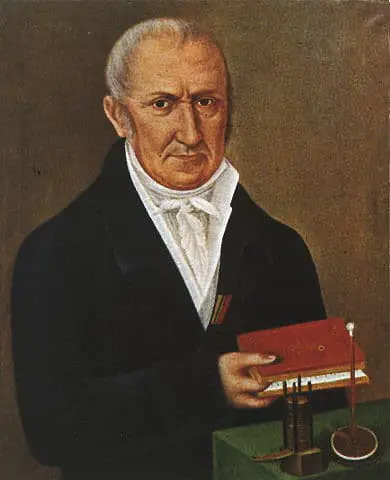
Alessandro Giuseppe Volta is an Italian physicist and chemist born in Como, Italy.
In his days, he was one of the founding fathers of electricity alongside Michael Faraday and Charles Wheatstone.
He earned himself a professor of physics accolade in 1774, a few years before he invented the battery.
Before inventing the first known battery, he switched in between chemistry and physics research before arriving at the battery in 1800.
He developed the electrophorus in 1775, an instrument that produces charges for static electricity.
After creating the battery, he was named after the electrical unit called Volt.
He finally retired and died years later in 1827.
4. Joseph Aspdin
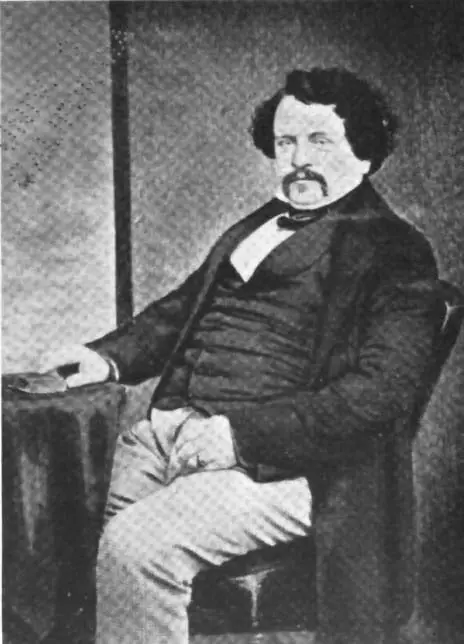
Aspdin was the first of six children, born in 1778 to a bricklayer who lived in Yorkshire. He went into his father’s profession but later became a builder.
He is also a father of a few inventions, one of the inventions defined the 1800s and shaped the industrial revolution at the time.
Later, he would discover limestone in his research, another invention he received a patent number for.
Before inventing the Portland cement, he married his fiancée in 1811 before becoming independent in his business in 1817.
He later moved the business to Liverpool after ending the partnership between him and Beverly, a co-worker.
5. Alexander Graham Bell
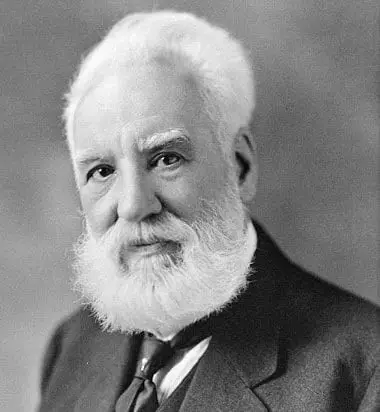
Graham Bell is a Scottish inventor whose life was well spent. He is one of the greatest men who ever lived and changed the 19th century.
Many things could be said about him again and again.
He was born in 1847, and he grew up with a professor dad who is a specialist in speech elocution at the University of Edinburgh.
He later became a professor at the age of 45, shortly after inventing the first telephone. He made the first device to reproduce and mechanize speech.
Throughout his life, Bell moved from London to Canada and the USA for health and career reasons.
He wasn’t a bright kid while he was young but had a great mind.
6. Charles Wheatstone
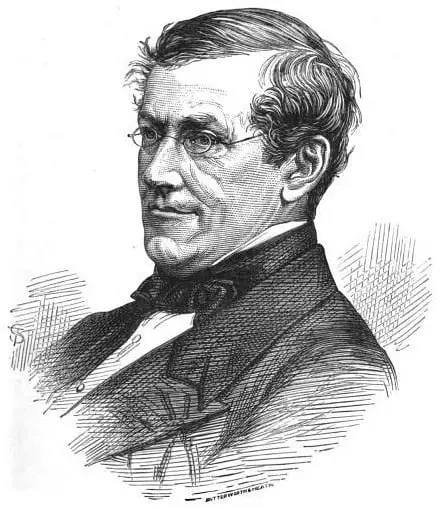
Charles Wheatstone is one of the greatest inventors to come from England.
He was born in 1802; his father was a shoemaker who had connections in show business, at the age of 4, Wheatstone’s family moved to London from Gloucester where his father produced wind instruments.
Charles Wheatstone got interested in his father’s sound instruments and fell in love with acoustics.
Despite being an inventor, he never divided his passion for music. He invented the Stethoscope, Wheatstone bridge.
All his inventions are still relevant and useful to date.
Later in life, he was knighted, and he gave up the ghost in 1875.
7. Kirkpatrick Macmillan

Another Scottish blacksmith is credited for designing the first pedal bicycle. He grew up learning in his father’s forge.
He got fascinated by a hobbyhorse and decided to build one personally. With the skills he gained from his blacksmith vocation, he made the first pedal bicycle.
He was born in the year 1812 and died on the 26th of January, 1878.
He wasn’t bothered about creating a fuss about his invention, people saw the need for a bicycle, but he just wanted a country life with his family.
His milestone of the invention is significant when listing various inventors of the bike. His bicycle still exists in a transport museum somewhere.
8. Rudolf Diesel

His name gives an inkling of how great a scientist and engineer he was in life.
Rudolf Christian Karl Diesel was the son of a popular Augsburg bookbinder, his mother, Elise Strobel, was a leatherworker.
He was born on the 18th of March, 1858 in Paris.
Theodore Diesel left France for London, and he returned Rudolf Diesel to Augsburg for academic reasons.
Diesel was a thermodynamics engineer after he graduated from a Polytechnic in Munich. He was late going to be a household name in the automobile industry water.
He built the first Diesel engine in 1893.
He was often regarded as a French-German engineer.
9. Samuel Morse
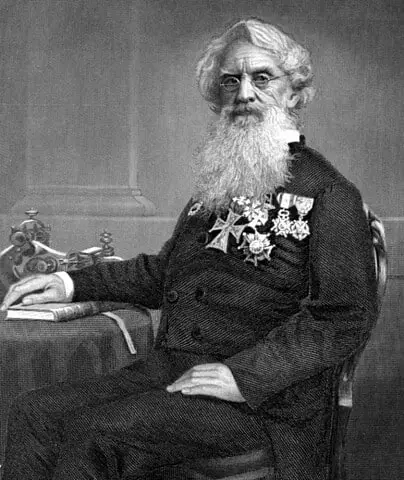
A famous American artist, scientist, and mathematician who was one of the three infant survivors from their parents.
Samuel Morse was born in 1791; his father was a geographer and a clergyman.
He is also famous for inventing the first known telegraph in 1834.
While growing up, he funded his education with art paintings he made and sold.
One of his paintings, The Judgement of Jupiter, hangs on the wall at Yale University Art Gallery.
His invention of the telegraph came as a result of the bad news he received from a horse messenger.
He concluded that his wife wouldn’t have died if there were a faster means of getting the news of her illness.
He also invented the Morse code.
10. Karl Benz
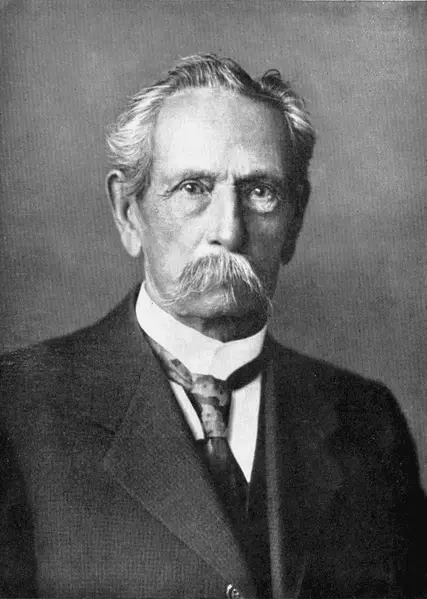
Benz became an orphan right from when he was 2 years old. He was born in 1844, and his family wasn’t wealthy.
After his father’s death, his mother carried all the burden of the family.
He graduated from polytechnic as an intelligent teenager and was always riding his uncomplicated bicycle to work.
Benz became an engineer and wasn’t satisfied with all the jobs he had, even though he always dreamt of building an automobile someday.
He left to begin a sheet metal workshop.
From the workshop, he started forging out different parts of the automobile he had in mind. In 1885, the first automobile was ready.
His wife Bertha traveled in the automobile for 107 kilometers before clearing his doubt through the telegraph that her journey was safe.
Conclusion
Considering these few major inventions in the 1800s, it is important to note how these inventions have impacted our industrial world positively.
Every industrialist and commercial leader owes them a lot for starting the revolution in their little corner.
Today, we have choices for different brands of inventions mentioned above.

